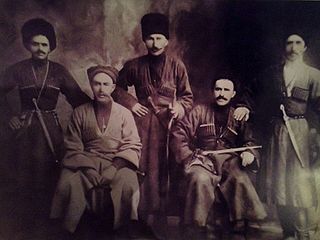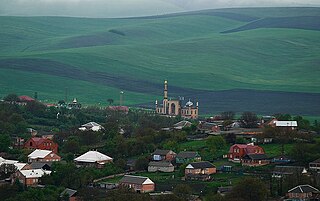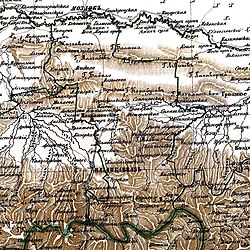
Vladikavkaz, formerly known as Ordzhonikidze (Орджоники́дзе) or Dzaudzhikau (Дзауджикау), is the capital city of North Ossetia-Alania, Russia. It is located in the southeast of the republic at the foothills of the Caucasus, situated on the Terek River. The city's population was 295,830 as of the 2021 Census. As a result, Vladikavkaz is one of the most populous cities in the North Caucasus region.

Nazran is the largest city in Ingushetia, Russia. It served as the republic's capital from 1991 to 2000, until it was replaced by Magas, which was built for this purpose. It is the most populous city in the republic: 122,350 (2021 Census); 93,335 (2010 Census); 125,066 (2002 Census); 18,246 (1989 Soviet census).
Sagopshi is a rural locality in Malgobeksky District of the Republic of Ingushetia, Russia. Population: 10,048 (2010 Census); 10,738 (2002 Census).

Sunzhensky District is an administrative and municipal district (raion), one of the four in the Republic of Ingushetia, Russia. It is made up of territory that was formerly part of the Sunzha Cossack Okrug. It is located in the eastern and central parts of the republic. The area of the district is 1,513 square kilometers (584 sq mi). Its administrative center is the town of Sunzha. As of the 2010 Census, the total population of the district was 116,470, with the population of Sunzha accounting for 52.9% of that number.

The Orstkhoy, historically commonly known under their exonyms: Karabulaks, Balsu, Baloy, are a historical ethnoterritorial society among the Chechen and Ingush peoples. Their homeland is in the upper reaches of the Assa and Fortanga rivers in the historical region of Orstkhoy-Mokhk. In the tradition of the Chechen ethno-hierarchy, it is considered one of the nine historical Chechen tukkhums, in the Ingush tradition as one of the seven historical Ingush shahars.
Galashki is a rural locality in Sunzhensky District of the Republic of Ingushetia, Russia, located on the left bank of the Sunzha River near the border with the Republic of North Ossetia–Alania. Its population was about 9,000 people in 2009. Galashki forms the municipality of the rural settlement of Galashki as the only settlement in its composition.
Bamut is a non-residential rural locality in Sernovodsky District of the Republic of Chechnya, Russia. From 1922 to 1934, Bamut was a part of the Ingush Autonomous Oblast.

Melkhista is a high-altitude historical region in the North Caucasus, located in the gorge of the same name. Today, Melkhista is a part of Motskaroyskoye rural settlement in Galanchozhsky District, Chechnya.

The Dzherakh, also spelled Jerakh, historically also known as Erokhan people, were a historical Ingush ethnoterritorial society, today a tribal organization/clan (teip), that was formed in the Dzheyrakhin gorge, as well as in the area of the lower reaches of the Armkhi River and the upper reaches of the Terek River.
Arshty is a rural locality in Sunzhensky District of the Republic of Ingushetia, Russia, located on left bank of the river Arshtynka near the border with the Republic of Chechnya. It forms the municipality of the rural settlement of Arshty as the only settlement in its composition.
Muzhichi is a rural locality in Sunzhensky District of the Republic of Ingushetia, Russia, located on the left bank of the Sunzha River near the border with the Republic of North Ossetia–Alania. It forms the municipality of the rural settlement of Muzhichi as the only settlement in its composition.

Yandare is a rural locality in Nazranovsky District of the Republic of Ingushetia, Russia. It forms the municipality of the rural settlement of Yandare as the only settlement in its composition.

Ekazhevo is a rural locality in Nazranovsky District of the Republic of Ingushetia, Russia. It forms the municipality of the rural settlement of Ekazhevo as the only settlement in its composition.

Barsuki is a rural locality in Nazranovsky District of the Republic of Ingushetia, Russia. It forms the municipality of the rural settlement of Barsuki as the only settlement in its composition.

Plievo is a rural locality in Nazranovsky District of the Republic of Ingushetia, Russia. It forms the municipality of the rural settlement of Plievo as the only settlement in its composition.

Surkhakhi is a rural locality in Nazranovsky District of the Republic of Ingushetia, Russia. It forms the municipality of the rural settlement of Surkhakhi as the only settlement in its composition.
Dattykh is a rural locality in Sunzhensky District of the Republic of Ingushetia, Russia, located on the left bank of the river Fortanga. It forms the municipality of the rural settlement of Dattykh as the only settlement in its composition.

Fortanga historically sometimes referred as Balsu, is a river in North Caucasus that flows in Ingushetia and Chechnya. The length of the river is 69 km, the basin area is 526 km2.

Targim is an ancient city-settlement in the Dzheyrakhsky District of Ingushetia. It is part of the rural settlement of Guli. The entire territory of the settlement is included in the Dzheyrakh-Assa State Historical-Architectural and Natural Museum-Reserve and is under state protection.
Gandalbos is rural locality in Sunzhensky District of the Republic of Ingushetia, Russia, located on the left bank of the river Fortanga. It is part of the municipality of the rural settlement of Dattykh.





















